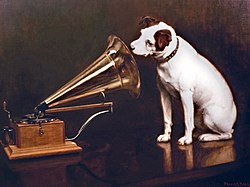As a kid growing up in Fairfax County, just a commute away from Washington D.C., I remember often looking out the window of the family car and seeing a statute of a huge dog cocking its head at a phonograph machine.

Here we see the sculpture on top of a museum roof in Baltimore, but when I knew it, it was set fairly far back in the front yard of someone with a sense of humor (or a desire to collect 15-foot fiberglass monuments to kitsch). I remember my mother telling me that the dog’s name was Nipper, and that he was listening to his master’s voice.
 A 2D version of this logo appeared on RCA records; it was the iPod dancing silhouette of its day — a visual icon used to market an audio technology.
A 2D version of this logo appeared on RCA records; it was the iPod dancing silhouette of its day — a visual icon used to market an audio technology.
I must have heard the story behind the scene — that the dog’s master is dead — because I remember imagining how big the master’s coffin would be in order to match the scale of these figures.
Exhaustive research led to me to some choice historical factoids about the RCA icon, including the story that a dog and a cylinder phonograph machine that belonged to a British man had both come into the possession of the man’s brother, after the man died. The inheritor was a British artist, who noticed the dog showed much interest in recordings of his late master, got the idea to sell the image to phonograph companies (under the original title, “His Late Master’s Voice”).
 The manufacturers of the cylinder machines didn’t bite, but a phonograph company eventually built an advertising campaign around the image, and the artist updated it to feature the more modern machine. His Master’s Voice (Wikipedia)
The manufacturers of the cylinder machines didn’t bite, but a phonograph company eventually built an advertising campaign around the image, and the artist updated it to feature the more modern machine. His Master’s Voice (Wikipedia)
A bit more Googling led to an entry in the Art Inventories Catalog, that gives the location I remember as 8731 Lee Highway, Fairfax, Virginia.



Nice post. Thought I’d comment that Michael Taussig has a good treatment of this icon (as an emblem of commodity fetishism) in his book, Mimesis and Alterity.